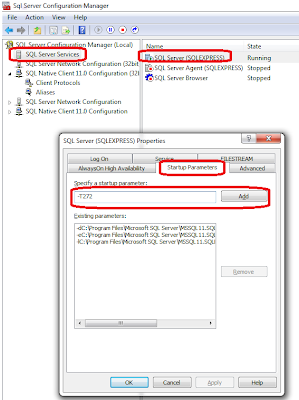Jumping identity problem
If you create table in MS SQL Server 2012 by using design mode then set identity column.
Sometime you will see your identity column jumping !!
Example 1, 2, 3, 12, 13 ,14
It 's OK if your data is not much. But if you have big data, it's will faster reach limit of column.
See this both script and see what's happen.
Example 1, 2, 3, 12, 13 ,14
It 's OK if your data is not much. But if you have big data, it's will faster reach limit of column.
See this both script and see what's happen.
Script 1
Script 1 is general table that can happen when created by design mode.CREATE TABLE [dbo].[testAuto]( [autoID] [tinyint] PRIMARY KEY IDENTITY(1,1) NOT NULL, [Name] [varchar](10) NOT NULL ) ON [PRIMARY]Script 2
CREATE SEQUENCE s1 AS INT START WITH 1 NO CACHE; CREATE TABLE [dbo].[testSequence]( [autoID] [tinyint] DEFAULT NEXT VALUE FOR s1, [Name] [varchar](10) NOT NULL ) ON [PRIMARY]
Script 2 is alter way that basic users may not know.
Then try to insert data then see result.
insert into testAuto(Name) values ('xxx')
select top 10 * from testAuto order by autoID desc
insert into testSequence(Name) values ('xxx')
select top 10 * from testSequence order by autoID desc
3 xxx 2 xxx 1 xxx 3 xxx 2 xxx 1 xxx
Result (Execute again 3 times)
14 xxx 13 xxx 12 xxx 3 xxx 2 xxx 1 xxx 6 xxx 5 xxx 4 xxx 3 xxx 2 xxx 1 xxx
So, you will see your identity column is jumping !!
In this example use tinyint, so normally you can insert 128 values.
But with jumping you may insert about 3-50 values (If in long term many many restart)
Solution
Method 1Use sequence instead of identity (example script 2)
But not recommend because you cannot use design mode, just for coding and must do every time.
Method 2
Add Startup Parameters "-T272" Recommend
Just one time config, then always apply to new table
- Open SQL Server Configuration Manager
- Left click on SQL Server Services
- Right click on SQL Server then select properties
- Add "-T272" in Startup Parameters
- Restart SQL Server

Test again by drop table.
drop table testAuto drop table testSequence drop sequence s1
insert into testAuto(Name) values ('xxx')
select top 10 * from testAuto order by autoID desc
insert into testSequence(Name) values ('xxx')
select top 10 * from testSequence order by autoID desc
6 xxx 5 xxx 4 xxx 3 xxx 2 xxx 1 xxx 6 xxx 5 xxx 4 xxx 3 xxx 2 xxx 1 xxx